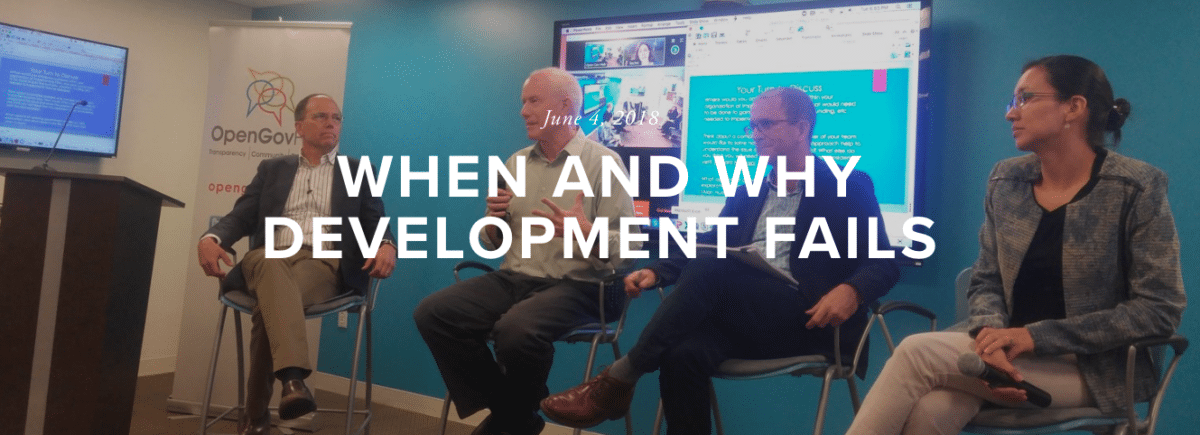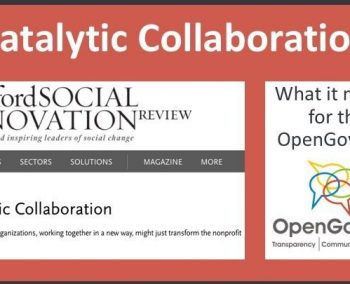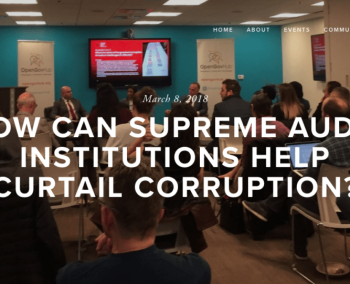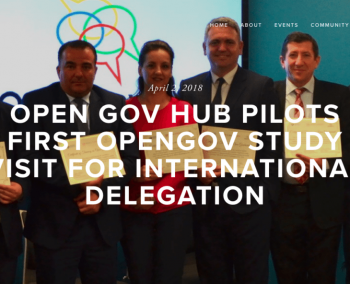When and Why Development Fails


***This post originally appeared on the Open Gov Hub’s blog on June 4, 2018***
On May 15, the Open Gov Hub hosted When and Why Development Fails: The Road to Building State Capability – convening leading experts to discuss why so many governments struggle to deliver basic services to their people, and how international development practitioners can better support the building of governments’ capacities, in light of the recent book Building State Capability (available at the link as a free PDF).
WATCH THE FULL EVENT FOOTAGE HERE
Open Gov Hub Director Nada Zohdy welcomed attendees and framed the conversation with three overarching questions, based on ongoing conversations at the Hub about doing development differently:
- Is governance perhaps the hardest form of all types of development to implement? If so, what tools do we need to do this work effectively?
- How can we avoid implementing so-called solutions in search of problems, and instead truly be problem-driven in our work?
- How can we better illustrate the instrumental value of open governance, not just relying on arguments about its intrinsic value (showing how open, participatory governance can be the smart thing to do for better outcomes, not just the right thing to do)?
Dennis Whittle (Feedback Labs) introduced the main presenter, emphasizing the outsized (perhaps even legendary) impact on his work is having on the field. Co-author Michael Woolcock (World Bank and Harvard Kennedy School) presented the book’s key concepts, stating that the underlying objective of the book and this work is to help governments do what they are supposed to do.

The first core challenge is that we have sky-high expectations for what governments worldwide should deliver, but their actually capacities are far lower. Even if we aim to help developing countries not reach the highest level of economic development (not “getting to Denmark”), but just get good enough to Portugal (which is the least developed of the OECD countries), we still find that most developing countries are hundreds of years behind. In fact, 90% of people in the developing world will still not live in a country as rich as Portugal by the end of this century. Clearly, there is a pervasive gap between what systems need to do versus what they can do.
So how should development practitioners respond? First, Woolcock advised being wary of inadvertently promoting “isomorphic mimicry” – when we encourage developing countries to copy and paste the form of developed institutions, without them being able to fulfill their actual function. One example was a multi-million project funded by Australian aid in the Solomon Islands, which build a large, world-class, sustainably-designed courthouse and prison. Sadly, this was a great waste of resources in the end because the judges of this particular council only meet twice yearly, and the prison only needed to accommodate a total of 8 prisoners.
Second, Woolcock argued we need to identify and institutionalize context-relevant successes (by looking for positive deviants in the developing world who buck trends and deliver strong outcomes), rather than start with the institutions that we think are the solution, and hope they will stick in any context.
Finally, Woolcock presented Problem-Driven Iterative Adaptation (PDIA) as a preferable approach – better than the “Big D” development approach of institutions like the World Bank of investing tremendously in the early planning stage to find so-called best practices then flatly implementing, or the “Small D” development approach of community-based NGOs that are highly niche and very difficult to scale. Rather, PDIA begins with locally-determined priority problems, explores and supports positive deviants, integrates tight experimental feedback/learning loops to constantly adapt and improve, and encourages the sharing of feasible practices with others to help promote scale.

Despite great challenges ahead, Woolcock ended on a hopeful note: if our grandparents’ generation could figure out how to end a world war and establish the first multilateral governance structure for all countries of the world, then we can rise to the challenge of this looming capacity vs. expectations gap.
Rachel Kleinfeld (Carnegie Endowment) then reacted. She argued that PDIA is important because:
- It focuses on process
- It creates a clear pathway to actually do development differently (not just critique other approaches)
- It brands these concepts and legitimizes this approach for risk-averse government leaders and existing innovators/positive deviants alike
However, she critiqued the book for hardly addressing the role of politics, and conflating state capacity with political will. She noted that PDIA can present a real challenge to experts, since it’s hard to be humble enough to have your sectoral expertise take a backseat and instead allow locals to identify their own problems and solutions.
Next, Alan Hudson (Global Integrity) discussed how Global Integrity supports locally-led innovations to promote open governance. Global Integrity is one of the few organizations that has been involved from the founding of both the Doing Development Differently/PDIA and Open Governance movements, and Hudson argued that we need to build more bridges between these two. He asserted that open governance advocates should be wary of copying and pasting so-called solutions (ex: supporting Open Data portals that are not actually a response to any problem) and should evaluate impact better, while Doing Development Differently advocates should recognize how openness can enable PDIA-style learning cycles, which in turn can help lead to more accountable governance.
Finally, Sandra Naranjo (IMAGO Global Grassroots and former Vice President of Ecuador) reacted to these ideas from her perspective as a former government minister and VP. She asserted that PDIA is less like an exact recipe and more like a useful way of thinking. It helped her persistently listen to her constituents until they uncovered the root of their problems. Now, her work is focused on helping grassroots organizations scale up solutions (from positive deviants). There is too often a great distance between people who design public policies and the person who actually receives the service, so she asserted we need to constantly put ourselves in the shoes of the end user/beneficiary and incorporate their perspective into our policy design to ensure that resonates with reality.
In discussion, the audience asked several questions, like:
- How can you get people to start thinking about complexity and complex systems?
- What’s the burning reason you can give for governments to change how they’ve always been?
- How can you make learning cycles uniform across organizations?
Woolcock stated the book doesn’t talk about politics because so many others have addressed this topic, while so little has been written about the administrative government capacity to help people who actually want to change their systems. As an impetus for governments to change, he pointed to the growing gap between what people expect and what governments can deliver, and reminded the audience that huge unmet expectations are why revolutions happen.

One of the best outcomes of PDIA, Woolcock stated, is to validate the struggle of heros who put in thankless efforts everyday to improve their communities even while knowing it’s a tremendously long haul, and helping them feel like part of a collective global effort. Finally, he reminded the audience that aggregating, evidence-based learning in this field is difficult. If the only “proven best practices” we have for parenting from 86 billion experiments throughout human civilization is that you should feed, hug and not beat your children, then we have to adjust our expectations of this deeply human, complex work of development and create space for ongoing, meaningful learning.
 |
Nada Zohdy
|
| Nada Zohdy is Director of the Open Gov Hub |
Leave a Reply Cancel reply
Related blog posts




